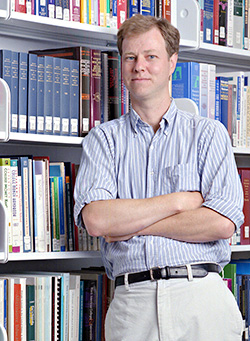A New Way to Judge Quality Teaching: By Watching It
"Too often teaching goes on unseen," says Thomas Hatch, Associate Professor of Education. "We call them public schools, but teachers are for the most part working in private, isolated classrooms."
For the past year, Hatch has been taking a video camera into local public schools and taping teachers in action. He then puts the footage into multimedia presentations on the Web to reach a broad community of educators. This April, Teachers College Record also published, "Making Teaching Public," an online digital exhibition that Hatch and his colleagues produced that documents teaching and learning in
Hatch's Web presentations not only give teachers and teacher educators a view of good teaching up close, they also allow instructors a chance to share their challenges and achievements with their peers. "The Web sites are a venue for connecting teachers with teachers," he says.
Ultimately, Hatch hopes to develop a multimedia collection of educators teaching a variety of content to a diverse range of students in different contexts and grade levels, so those viewers can find examples of teaching that resonate with their own teaching experience.
"I want a teacher to say, -'Yeah, this Web site actually begins to get at some of the complexities that I have to deal with in my classroom,'" he says, explaining that video often conveys these complexities more effectively than written case studies. On-the-spot decision making, altering lesson plans and assignments to fit classroom dynamics, interactions with students: these are often hard to capture with words, yet they are the very things teachers, especially new teachers, want help with. The Web sites give them access to real situations and strategies.
Hatch was inspired to make teaching public as a result of his own experience of classroom isolation. "In working with teachers in higher education, I suddenly realized there were all kinds of teaching, courses, activities and assignments I'd never experienced," he says. "We're really confined to our own experiences with what goes on in the classroom, and I think that is really limiting."
Hatch started using cameras and the Internet to open classroom doors 10 years ago, when he was working at the Carnegie Foundation for the Advancement of Teaching. He has since carried on the work through The National Center for Restructuring Education, Schools and Teaching (NCREST), based at TC, where he is Co-Director.
Hatch stresses that capturing classes on tape is not easy. Busy schoolrooms are often loud and poorly lit. There are issues of permission, privacy and intellectual property. For teachers, being filmed on the job "can be daunting," he says. There also are questions about what to videotape and how to edit the footage, as well as how to design the Web sites so viewers get a deep sense of the content without being overwhelmed with too much information.
That said, educators are generally eager to share their teaching experience. "For the most part they've welcomed this opportunity with open arms," says Hatch, who is especially pleased when viewers personally respond to the educators who appear in the Web sites. "The teachers have this sense of discovery that there are people out there who care about what they're doing, and these teachers have never had that before. For me, it's tremendously fulfilling to help build those connections."
Ultimately, Hatch wants his Web work to reach the general public. As a parent of three young children, he experienced first-hand the frustration of trying to learn what was going on in the actual classrooms of elementary schools. "When we moved to New York four years ago, all we had to go on in terms of picking schools were those magazine articles, those ratings and statistical digests that talk about test scores and demographics but don't tell you anything about what's really going on inside the schools. I had to go to 15 different elementary schools around
Hatch envisions a public record of Web sites where parents can go in and see examples of teaching and curricula offered in local schools. "Then parents will have a whole new means of understanding and thinking about where they'd like their kids to grow up," he says.
His multimedia work, "Images of Teaching," can be found on the NCREST Web site at www.tc.edu/ncrest/images.htm. "Making Teaching Public" can be found through Teachers College Record at www.tcrecord.org/makingteachingpublic.
Published Thursday, Apr. 26, 2007
